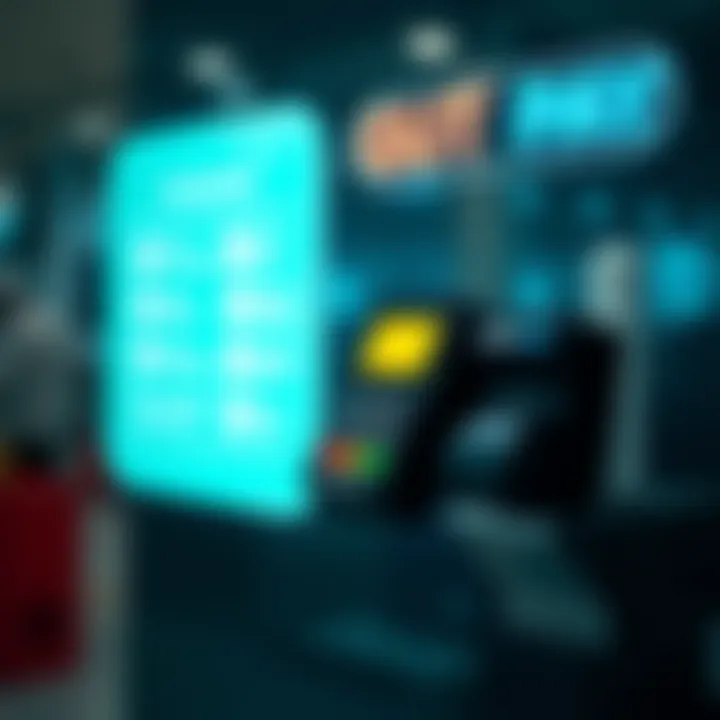Efficient Payment Solutions: Etihad Water Quick Pay


Intro
As utility services evolve, the need for efficient payment solutions becomes ever more critical. In the UAE, consumers face a unique set of challenges when it comes to managing their utility bills, especially with water and electricity provided by Etihad Water and Electricity. This is where the Quick Pay service enters the conversation.
It simplifies the payment process, allowing users to pay their bills swiftly and conveniently. This article will unpack how the Quick Pay feature operates, highlight its myriad benefits, and explore how it caters specifically to consumer needs within this diversified economic landscape. The utility market in the UAE is not just about service delivery; it's about making that delivery as seamless and efficient as possible for both the providers and the consumers.
Enter the realms of user experience where payment methods are crucial—credit cards, mobile wallets, or perhaps automated bill payments are on the rise. Navigating through these options, consumers learn not just about the ease of use but also about optimizing their payments to avoid late fees and disconnections. The Quick Pay service stands as a bridge, guiding users toward timely and efficient payments, and, in turn, smoothening their everyday lives.
In this exploration, we’ll also touch upon market trends, insights from users, and ways consumers can harness the full potential of Quick Pay. This isn't merely an investigation of a service; it's a roadmap for navigating utility payments in a digital age. Let’s dive deeper.
Preface to Etihad Water and Electricity
In today’s fast-paced world, utility services play a critical role in the daily lives of residents and businesses alike. The importance of efficient management and payment solutions cannot be overstated, especially in a dynamic market like the UAE. Understanding Etihad Water and Electricity offers insights into how this vital utility provider shapes the landscape of energy and water services in the region, streamlining processes for consumers and businesses.
This section provides an essential foundation for the discussion on Quick Pay, a service designed to simplify and enhance payment methods, thus ensuring that users meet their utility obligations promptly and efficiently. When drinking water and electricity are at stake, knowing how to navigate these systems with ease, quickly becomes essential.
The focus here is not just on the functions of Etihad Water and Electricity, but also on the broader context of utility services in the UAE. Here, innovation meets tradition, and understanding this dichotomy is crucial for effectively utilizing these services. Consumers today often juggle multiple bills, so having a solid grasp of the utility systems in place saves both time and headaches, allowing more focus on other pressing matters.
Overview of Utility Services in the UAE
Utility services in the UAE encompass a wide array of provisions, including water supply, electricity generation, and waste management. Each emirate may have its own specific providers or frameworks, but some overarching entities work to maintain consistency across the board.
The rapid growth of urban centers has induced an increased demand for such services. Given the region's unique environment and climatic conditions, the delivery of these services requires not only infrastructure but also careful planning and consideration of sustainability practices.
- Water Supply: This includes sourcing fresh water, treatment processes, and ensuring distribution to households and businesses.
- Electricity Generation: The UAE's heavy reliance on electricity necessitates a robust grid and access to different forms of generation, from traditional fossil fuels to solar power initiatives.
The continued development of efficient payment solutions is vital in keeping pace with growth, allowing for a seamless transition for both residents and service providers.
Role of Etihad Water and Electricity
Etihad Water and Electricity serves as a cornerstone in the framework of utility services in the UAE, providing both water and electricity efficiently to millions. Their primary role includes overseeing the production, distribution, and billing of these essential services.
- Efficiency: They work diligently on projects that enhance the efficiency of service delivery, particularly important as demand continues to surge.
- Sustainability Initiatives: The organization is committed to sustainable practices, aiming to reduce waste and optimize resources, which is imperative in a region known for its scarce fresh water.
- Innovative Payment Systems: By rolling out systems like Quick Pay, they facilitate timely payments, minimizing disruptions in service and ensuring a more financially stable environment for consumers.
These roles are increasingly synergistic with modern technology trends, bridging the gap between old methods and new innovations that benefit consumers in multiple ways.
Understanding Quick Pay
The Quick Pay service introduced by Etihad Water and Electricity has become a vital cog in the wheel of utility payment solutions in the UAE. Understanding this service is essential for anyone looking to streamline their utility payments and avoid unnecessary hassles. It stands out as a user-friendly, accessible option amidst the often convoluted and time-consuming traditional payment methods. With a focus on efficiency and customer satisfaction, Quick Pay addresses several pain points that consumers regularly encounter.
Definition of Quick Pay
Quick Pay can be defined as a streamlined payment platform designed for consumers of Etihad Water and Electricity. This service enables customers to settle their utility bills swiftly and effortlessly, with transactions capable of being completed in just a few clicks. The approach taken by Quick Pay significantly reduces the steps involved in the payment process, thereby minimizing friction for users who are often pressed for time.
At its core, Quick Pay is about immediacy and ease. Users can access the service through various avenues, including mobile applications and online portals. This flexibility caters to different transactional preferences, whether one prefers the touch of a smartphone or the robustness of a desktop. The beauty of Quick Pay lies not only in its accessibility but also in its capability to handle multiple payment methods, allowing consumers to choose what suits them best.
Purpose of Quick Pay Service
The purpose of the Quick Pay service is multifaceted, primarily aiming to enhance the consumer experience while ensuring timely utility payments. Below are some key purposes that underline why this service has gained traction among users:
- Convenience: Quick Pay caters to a busy demographic that values efficiency in their day-to-day tasks. Users can pay their bills anytime and anywhere, without being tied to lengthy queues or traditional office hours.
- Enhanced Transparency: By utilizing a digital platform, consumers benefit from clearer transaction histories and real-time updates on their account status. This transparency allows individuals to track payments easily and manage expenses more effectively.
- Reduced Late Payments: The design of Quick Pay inherently encourages timely payments. With reminders and straightforward processing, consumers are less likely to forget their due dates, thus helping them avoid late fees.
- Adaptable Payment Options: The service provides consumers with multiple payment channels, from online banking to credit and debit card options, accommodating varying consumer preferences and fostering inclusivity in payment solutions.
"In a world where time is money, Quick Pay gives consumers the best of both—efficiency and ease in managing utility payments."
By understanding the Quick Pay service, consumers are better equipped to take advantage of its many benefits, reinforcing its role in the evolving landscape of utility service management. Through its purpose-driven design and focus on user experience, Quick Pay effectively addresses an essential need in the UAE's utility sector.
Mechanics of the Quick Pay System


The mechanics of the Quick Pay system is crucial in understanding how this service enhances the utility payment experience for consumers in the UAE. This section sheds light on specific elements that underline its functionalities and the considerations around its use. Quick Pay's design significantly reduces friction in utility payments, turning what was once a mundane task into a more manageable and efficient process.
How Quick Pay Works
Quick Pay operates via a straightforward interface that guides users through the payment process. At its core, the system utilizes a centralized platform where consumers can access their utility bills, review their account details, and complete payments with just a few clicks. The underlying principle is simplicity and speed. When a user logs in, they typically see a dashboard displaying their current balance and previous transactions.
Once they input their payment details—be it credit card information or bank account numbers—the system securely processes the transaction and instantly updates the user's balance. An important aspect worth noting is its real-time capabilities; balances are updated immediately, reducing the worry of late payments.
This system runs on secure protocols designed to protect user data. As such, understanding how these data protections work can further increase consumer confidence in using Quick Pay.
Payment Methods Available
The diversity in payment options can be seen as one of the** standout features of the Quick Pay system**. Various methods cater to different user preferences, ensuring that everyone can find a convenient way to settle their utility bills. The three primary methods include online payments, mobile app transactions, and payment kiosks.
Online Payments
Online payments are perhaps the most straightforward method offered through Quick Pay. Many consumers appreciate this option as it allows for quick access from anywhere; whether at home or work, people can make payments using their laptops or tablets. The key characteristic of online payments is their accessibility. Users can simply visit the Etihad Water and Electricity website, enter their information, and get it done in a jiffy.
A unique feature of these online transactions is the provision for automated billing. Once a user is registered, they can choose to receive notifications for upcoming dues, making it easier to plan their finances. However, one should also consider that online payments might encounter outages, and in the rare event of a technical glitch, users could face temporary inconveniences.
Mobile App Transactions
For those always on the go, mobile app transactions offer a powerful alternative. The mobile application for Quick Pay is designed with usability in mind, featuring an intuitive interface that minimizes steps required to process payments. This convenient option allows users to pay bills quickly, no matter where they find themselves—their apartment, a coffee shop, or basically anywhere with an internet connection.
A particularly advantageous aspect is the app's functionality to store previous payment methods securely. This feature ensures that routine transactions become even more swift. However, users might face challenges with app compatibility across different devices. Every now and then, there are updates that some older smartphone models may not support.
Payment Kiosks
For consumers who are less inclined towards technology, payment kiosks represent a reliable option. Found in various locations across the UAE, these kiosks allow users to pay their bills in person using cash or card. A defining trait is their tangible nature, as some feel more comfortable handling money physically rather than through digital platforms.
Kiosks are particularly beneficial for those who may lack internet access at home or prefer the in-person experience. Consequently, they are a vital part of the overall Quick Pay ecosystem. Nonetheless, the downside might include waiting in line during peak hours, where extended wait times can lead to frustration.
"Given the diverse needs of its customers, Etihad Water and Electricity's Quick Pay system accommodates a variety of payment methods, ensuring a seamless experience for all."
In sum, the mechanics of the Quick Pay system span across multiple convenient methods. Each approach offers unique benefits while also coming with certain considerations. As consumers explore their options, understanding these elements will help them make informed decisions about how they handle their utility payments.
Benefits of Using Quick Pay
In today’s fast-paced world, convenience is king. The Quick Pay service offered by Etihad Water and Electricity is no exception to this trend. This system is designed to streamline utility payments for consumers, ensuring that the billing process is as simple as pie. Understanding the benefits of using Quick Pay provides clarity on why it is an integral part of the utility payment landscape in the UAE.
Convenience for Consumers
One of the standout features of the Quick Pay service is its sheer convenience. Gone are the days when one had to stand in long queues or navigate complex procedures just to clear a utility bill. Now, the service allows consumers to pay their bills anytime and anywhere, whether they are at home lounging on the couch or busy juggling their daily commute.
With options like online payment via the Etihad website, mobile app transactions, and even payment kiosks strategically placed throughout urban centers, the reach of Quick Pay is extensive. This flexibility meets the consumers where they are, making the entire process more accessible.
“Bite-sized convenience” might just be the best term to describe how Quick Pay functions; it offers a range of payment methods that cater to every lifestyle, thereby alleviating the stress typically associated with paying bills.
Time Efficiency
Time is a valuable commodity—and that’s an understatement! Quick Pay enhances time efficiency significantly. The process is designed to be quick and straightforward, reducing time spent on payments to mere minutes. Users no longer need to schedule extra time to drop off payments or wait for processing confirmations.
Imagine someone busy with work commitments or family obligations. With Quick Pay, they can simply log on to their mobile devices, make their payment, and get back to their day. By cutting out unnecessary wait times, consumers gain precious minutes that can be better spent on activities with a more favorable return.
Furthermore, the system sends automatic reminders, so users won’t inadvertently miss a deadline. Immediate notifications also lend a hand in achieving timely settlements. Efficiency, after all, is more than just saving minutes; it’s about redirecting those moments toward what truly matters.
Reduced Incidents of Late Payments
Late payments can often lead to cumbersome penalties and unwanted disruptions to service, which nobody wants. The Quick Pay service is instrumental in minimizing such occurrences. Thanks to its seamless functionality and real-time reminders, users can stay on top of their payments without feeling overwhelmed.


The intuitive design and user-friendly interface help to demystify utility payments. On the other hand, missing a deadline becomes a thing of the past, as consumers receive timely alerts on due dates. Less worry about missed payments translates into enhanced peace of mind.
A study pointed out that late fees can add up quickly, making punctuality in payments a financially savvy choice. Quick Pay not only helps users avoid these extra costs but also encourages responsible financial behavior overall. By making timely payments the norm, the reliability of utility services can also be preserved for everyone involved.
In summary, the benefits of using Quick Pay are not just about convenience; they speak to larger themes of efficiency and financial prudence.
As we delve deeper into the user experience and further aspects of the Quick Pay system, it becomes evident that understanding these fundamental benefits lays the groundwork for a more profound appreciation of what modern utility payments can achieve in the UAE.
User Experience Analysis
User experience plays a pivotal role in determining the effectiveness and acceptance of any service, especially in the fast-evolving sphere of utility payments. In the case of the Quick Pay service provided by Etihad Water and Electricity, user experience encompasses factors such as ease of use, accessibility, feedback mechanisms, and overall satisfaction. A deep dive into these areas reveals much about how well the service meets the needs of its users and how it can be optimized further.
Understanding user experience isn’t just about measuring satisfaction; it’s also about identifying gaps and opportunities. By analyzing how consumers interact with Quick Pay, we can unveil concrete insights about usability and functionality. This analysis helps to refine the service, enhance user engagement, and ultimately lead to improved payment practices across the board.
Consumer Feedback on Quick Pay
Consumer feedback has always been a critical element in shaping services. For Quick Pay, user testimonials highlight a variety of experiences that range from positive affirmations to constructive criticism. Many users appreciate the efficiency of the service, expressing that the seamless payment process is a breath of fresh air compared to traditional methods. They often mention how they can make payments swiftly from the comfort of their homes, utilizing the mobile app or website without the need for physical visits to payment centers.
Some key points from consumer feedback include:
- Accessibility: Users note that the service is easy to navigate, making it suitable for individuals of all ages and tech-savviness.
- Time-saving: Many have expressed that it allows them to settle their utility dues in a matter of minutes, avoiding the hassle of queuing.
- Safety and Security: Customers often feel more secure using electronic transactions, as Quick Pay offers robust security measures and transparent transactions.
However, it's not all rosy. Some users have reported issues such as payment failures or technical glitches while using the mobile application. Such feedback helps Etihad Water and Electricity pinpoint problems that need addressing, which can ultimately improve the overall experience and utility of Quick Pay.
Challenges Faced by Users
Every good service faces its share of hurdles, and Quick Pay is no exception. As convenient as it may be, users encounter various challenges that can detract from their overall satisfaction with the payment process. Recognizing these obstacles provides valuable insights into areas for improvement.
Some of the notable challenges include:
- Login Difficulties: Users have sometimes experienced issues accessing their accounts due to forgotten passwords or technical errors, which can be frustrating. According to user feedback, the resetting process can be cumbersome and not as intuitive as hoped.
- Payment Processing Times: A few users reported delays in payment confirmations, leading to confusion about whether their payments have been allocated properly. This uncertainty can foster anxiety, especially when deadlines loom.
- Customer Support Limitations: While some users have praised the support team for being helpful, others noted that response times can vary significantly, leaving them in a lurch when urgent assistance is needed.
Addressing these challenges requires ongoing commitment and proactive strategies from Etihad Water and Electricity. Enhancing user support, streamlining the login process, and improving system performance are essential steps toward maximizing user experience.
"Understanding the user experience is not merely an analysis but a continuous journey toward improvement—one feedback at a time."
Comparative Insights
Understanding the nuances of different payment options is crucial for consumers navigating the utility landscape in the UAE. With the rise of digital solutions like Quick Pay provided by Etihad Water and Electricity, it's vital to examine how these modern methods stack up against traditional approaches. This comparison not only sheds light on immediate benefits, such as convenience and speed, but also highlights broader implications about consumer behavior and industry standards.
Quick Pay vs. Traditional Payment Methods
When evaluating Quick Pay alongside traditional payment methods, several factors come into play. Traditional methods, such as cash or check payments, often require consumers to physically visit payment centers or banks, which can be time-consuming and inconvenient. On the other hand, Quick Pay allows users to manage their bills from the comfort of their homes or anywhere with internet access. Here are some standout differences:
- Speed: Quick Pay transactions are usually processed instantly, while traditional methods can take days for checks to clear.
- Accessibility: With online platforms, users can pay their bills at any hour without having to adhere to the operating hours of physical locations.
- Record Keeping: Quick Pay usually comes with digital receipts and transaction histories, making it easier for users to track their payments compared to paper trails of traditional methods.
In essence, Quick Pay is not just about keeping up with the times; it is about ensuring that payments are made without complications. The ease of use and instant feedback significantly affect consumer satisfaction, leading many to prefer newer methods over traditional ones.
Regional Comparisons of Utility Payment Services
A closer look at how utility payment solutions differ across regions reveals varied adaptations and innovations. In the UAE, Etihad Water and Electricity’s Quick Pay stands out when placed against similar services in neighboring countries. For example:
- Saudi Arabia’s GAZT Online Services: Here, users also enjoy the convenience of online bill payments, but the interface and user experience can differ. Some consumers have reported challenges with navigating the website compared to Quick Pay.
- Kuwait’s Ministry of Electricity and Water: This service offers an app for payments, but it does not integrate as many user-friendly features, which Quick Pay provides, such as reminders or auto-pay setups.
The effectiveness of these systems often comes down to how well they cater to their target audience and how convenient they make bill payment. An established relationship with consumers is key, and regions that embrace technology seem to foster higher levels of satisfaction among users.
"As we move further into a digital age, how we pay for utilities reflects not just innovation, but our expectations as consumers for efficiency and transparency."


Best Practices for Optimizing Quick Pay Usage
Adopting best practices for utilizing the Quick Pay service can significantly enhance user experience and ensure timely utility payments. As the landscape of utility management continues to develop, incorporating effective strategies becomes increasingly important. By maximizing the efficiency of the Quick Pay service, users can navigate their utility costs with ease, ensuring they remain on top of their payments without unnecessary stress.
Setting Reminders for Payments
One of the key practices users can implement is setting reminders for when payments are due. In an age where our schedules are packed tighter than a suitcase on a long trip, making use of technology can alleviate forgetfulness. Utilizing your smartphone’s calendar or a task management app helps put you in the driver’s seat. A notification pinging you days before the payment is due assures that you won’t find yourself in a frantic scramble come the final hour.
- Consistency is Key: Regularly updating your payment information in your reminders keeps them relevant and accurate. Make sure to adjust for changes in your financial situation or billing cycle.
- Timing Matters: Remind yourself a few days before the payment deadline. This buffer gives you room to adjust if ever unforeseen circumstances arise.
- Multi-Channel Reminders: Consider employing various channels; whether an app notification, an email alert, or even a simple sticky note on your fridge, diversifying your reminders can reduce your chances of overlooking a payment.
By creating a habit around these reminders, users empower themselves to maintain control over their financial commitments more effectively. This small practice can lead to a noticeable decrease in late payment fees and improved credit standings over time.
Using the Mobile App Effectively
In today's fast-paced world, having the right tools at your fingertips can make all the difference. The mobile app for Quick Pay often serves as the digital gateway for managing payments seamlessly. To make the most out of it, users should familiarize themselves with its features and functionalities.
- Explore Navigation: Take the time to familiarize yourself with the app's layout. Knowing where everything is located can save you precious minutes when making payments.
- Utilize the Payment History: The app typically provides a history of previous payments. Reviewing this can assist in budgeting and forecasting future bills. This is critical for effectively managing finances, particularly for those who pay multiple utility bills.
- Set Up Autopay: If you’re generally reliable with your finances, consider setting up autopay. This will ensure that you never miss a deadline. Of course, keep an eye on your balance to prevent overdrafts.
- Keep it Updated: Regularly update your app to ensure you have the latest features and security measures. Sometimes, developers introduce enhancements that could further streamline your payment process or add new functionalities.
By leveraging the mobile app's capabilities, users can optimize their Quick Pay experience, turning a once cumbersome task into a quick and effortless routine.Throughout the month, with a few taps on your screen, all worries about utility payments can fade into the ether.
“An ounce of prevention is worth a pound of cure.” - Benjamin Franklin. This couldn't ring truer in the realm of utility payments, where a consistent approach can spare you from the hassles of late fees and disconnections.
In summary, adopting these best practices not only simplifies the utility payment process but also fosters a sense of financial stability and accountability. Given the advancements in digital payment systems, taking a proactive approach to these tools can lead to lasting positive outcomes.
Future of Utility Payments in the UAE
Navigating the future of utility payments in the UAE is akin to charting a course through uncharted waters. As technology evolves, so too must the systems we rely on for our everyday needs, such as electricity and water. The quick pay service introduced by Etihad Water and Electricity is just the beginning of what we can expect in this rapidly transforming landscape.
The importance of understanding this allocation comes from its numerous benefits, which can substantially enhance the consumer experience while ensuring financial transactions are both secure and swift. The landscape of utility payments is not just about convenience; it also encompasses issues of sustainability and efficiency, which are becoming increasingly vital in today's world.
Emerging Technologies in Payment Systems
The advent of emerging technologies is reshaping how consumers interact with utility providers. Payment systems are no longer simply transactional; they now embrace artificial intelligence, blockchain, and mobile technologies. These innovations create a seamless experience for the consumer while bolstering security. For example, blockchain technology offers a decentralized ledger that not only enhances security but also ensures transparency in billing.
Many companies are beginning to integrate mobile wallets and contactless payment solutions, which can speed up transactions and minimize the hassles associated with traditional methods, such as dealing with cash or checks. Similarly, AI-powered chatbots are providing consumers with instant support concerning their utility payments, answering questions, and guiding them through the payment process.
"With the incorporation of smart technologies, we are witnessing a shift that could potentially diminish payment-related friction, leading to an elevated customer experience."
Impact of Smart Technologies on Utility Services
The integration of smart technologies is revolutionizing utility services in unprecedented ways. With smart meters now commonplace in many households, consumers are not only more mindful of their consumption but also have access to real-time data. This switch allows customers to track usage and costs, making it easier to budget and manage expenses.
Moreover, smart technologies facilitate dynamic pricing models that send consumers notifications during off-peak hours when rates might be lower. This practice empowers consumers to make informed decisions that consequently lead to cost savings. In time, as smart grid solutions become more widespread, utility companies can anticipate demand fluctuations, leading to better resource allocation and energy distribution.
In summary, the future of utility payments in the UAE appears bright due to innovative technologies and smart systems. As these advancements continue to evolve, they will deliver a more efficient, transparent, and user-friendly experience for all stakeholders involved, ultimately making utility services more accessible and reliable.
Ending
The conclusion serves as a vital summation of the detailed insights presented throughout this article regarding the Quick Pay service provided by Etihad Water and Electricity. As the utility landscape in the UAE undergoes significant transformation, understanding the mechanisms, benefits, and challenges associated with Quick Pay is essential for consumers and stakeholders alike.
Summarizing Key Insights
As we dissect the nature of Quick Pay, several key insights emerge:
- User-Friendly Interface: The system allows for streamlined transactions, making it easier for consumers to access and manage their utility payments.
- Variety in Payment Options: Quick Pay's flexibility in payment methods ensures that users can choose what's most convenient for them which caters to a diverse group of clients.
- Time Efficiency: By offering a swift and effective way of handling bills, Quick Pay minimizes the time spent on payments and reduces the worry over late fees.
- Future-Oriented Features: As it develops further, Quick Pay is expected to integrate even more advanced technologies.
- User Feedback: Harnessing consumer feedback helps in refining the service, ensuring it meets evolving needs.
These insights underscore the importance of Quick Pay not only as a tool for easy transactions but also as a contributor to greater satisfaction among users, ultimately fostering a more efficient economy in the utility sector.
Final Thoughts on Quick Pay
In light of all discussed points, Quick Pay emerges as more than just a payment method; it stands as a significant player in the future of utility services in the UAE. The advent of digital solutions such as Quick Pay marks a shift towards a modernized approach in handling utilities, promoting convenience and efficiency for consumers.
Being aware of how to leverage this service offers users a chance to navigate their utility accounts with ease. As the UAE's technological landscape evolves, Quick Pay is likely to be at the forefront, making way for further innovations that will benefit all stakeholders involved. Proper engagement and continuous adaptation to user needs will ensure that Quick Pay remains a reliable choice in utility payments.
"With quick solutions comes not just ease, but also empowerment in managing one’s resources wisely."







